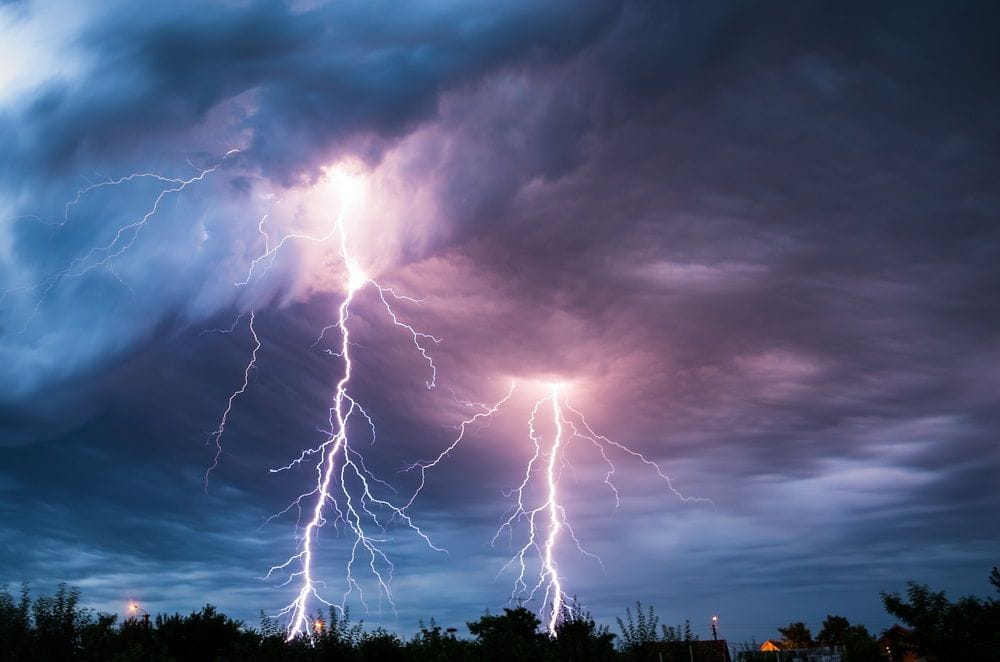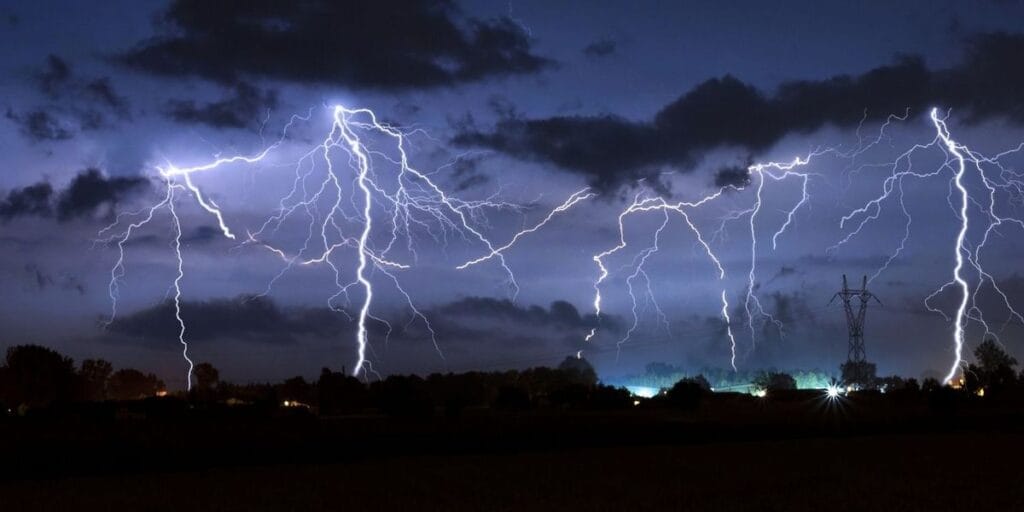Have you ever wondered what makes the sky crackle with bright bolts and booming sounds? And what are the causes of lightning? Lightning and thunder are more than just dramatic weather. They’re electrifying science in action! Let’s break down how nature puts on one of its loudest shows.
What Causes Lightning?
Lightning forms when opposing electrical charges build up in a thunderstorm cloud. As the storm intensifies, friction between ice crystals, water droplets, and rising warm air causes a separation of charges. A negative charge typically gathers at the bottom of the cloud, while a positive charge accumulates near the ground. Once the electric field becomes strong enough, the difference triggers a discharge known as lightning.
How Does a Thunderstorm Lead to Lightning?
Lightning forms when opposing electrical charges build up in a thunderstorm cloud. As the storm intensifies, friction between ice crystals, water droplets, and rising warm air causes a separation of charges. A negative charge typically gathers at the bottom of the cloud, while a positive charge accumulates near the ground. Once the electric field becomes strong enough, the difference triggers a discharge known as lightning.
What is the Role of Electrical Discharge in Lightning Formation?
An electrical discharge plays a crucial role in the formation of lightning. As charge separation develops within the cloud, the electric field strengthens until it overcomes air resistance. At that point, a channel of ionized air—called the lightning channel—forms and connects areas of opposite charge, allowing a massive discharge of energy that we observe as a flash of lightning.
Did you know that lightning is about five times hotter than the surface of the sun?
How Do Positive and Negative Charges Create Lightning?
In any active thunderstorm cloud, negative charges settle in the lower region, while positive charges accumulate at the top and on the ground. When the difference between the positive charge and negative charge becomes extreme, the air breaks down and a lightning strike forms. This interaction of positive and negative charges explains why lightning occurs during even mild parts of the storm.
How Does Lightning Occur During a Thunderstorm?

To understand how lightning occurs during a thunderstorm, it’s important to observe what happens inside the cloud. As vertical winds rise and fall, they carry ice crystals and water droplets that build up opposite charges. When the negative charge in the cloud becomes intense enough, it seeks a connection with the positive charge on the ground, releasing a bright lightning flash through the lightning channel.
What Happens in a Thunderstorm Cloud?
Inside a thunderstorm cloud, powerful currents push moist air upward, cooling it rapidly. This forms dense concentrations of ice crystals and water droplets, which collide and separate charges. The base of the cloud becomes negatively charged, while the top carries a positive charge. As this imbalance grows, it eventually results in a lightning strike when charges equalize through an intense discharge.
What Types of Lightning Flashes Are There?
Various lightning flashes occur depending on the type and position of the cloud. The most well-known is cloud-to-ground lightning, where energy discharges from the cloud to the earth. Others include intra-cloud lightning, where energy moves within a single cloud, and cloud-to-cloud flashes, which travel between multiple clouds. Each type reveals different paths of lightning discharge.
How Do Ice Crystals and Water Droplets Contribute to Lightning?
Inside thunderstorm clouds, collisions between ice crystals and water droplets are essential to lightning development. These impacts cause charge separation, with negatively charged particles drifting to the base of the cloud and positively charged particles rising. Without this movement and buildup of charge, the electric field would not reach the strength needed to initiate a lightning strike.
What is the Connection Between Lightning and Thunder?
The connection between lightning and thunder lies in the rapid heating of air. When a flash of lightning streaks through the cloud, the surrounding air becomes hotter than the surface of the sun. This sudden expansion produces a shockwave, which travels as sound. What we call thunder. Therefore, every time you see lightning, you will eventually hear thunder, depending on your distance from the lightning strike.
How is Thunder Created by Lightning Discharge?
Thunder results directly from the explosive discharge of lightning. When electricity surges through the lightning channel, it heats the air to extreme temperatures. This causes the air to expand faster than the speed of sound, generating a loud clap. The rumble of thunder varies depending on how far the lightning strike occurred and how the cloud structure affects sound travel.
Did you know there are over 3 million lightning strikes on Earth every day?
Can You Hear Thunder From a Lightning Strike?
Yes, you can always hear thunder after a lightning strike. If you are close enough. Since thunder travels slower than light, there’s often a delay between the flash of lightning and the sound. If the lightning occurs far away, the thunder may be faint or even inaudible. But during any thunderstorm, distant rumbles usually indicate lightning is active within clouds overhead or near the ground.
What Are the Causes of Thunder After Lightning?
Thunder is caused by the superheated air surrounding a lightning channel. When lightning occurs, the electrical discharge instantly raises air temperature, making it expand violently. This rapid expansion compresses the surrounding air, creating the sound wave we recognize as thunder. So the cause is not just the lightning itself, but the heat and pressure it generates in the cloud.
What Are the Different Types of Lightning Strikes?
There are several forms of lightning strikes, each depending on how the cloud distributes electrical charges. Cloud-to-ground lightning is the most dangerous, striking the earth directly. Intra-cloud lightning remains within a single cloud, while cloud-to-cloud travels between separate thunderstorm clouds. Occasionally, triggered lightning occurs when tall structures initiate the discharge.
What is Cloud-to-Ground Lightning?
Cloud-to-ground lightning happens when a negative charge at the base of a cloud connects with a positive charge near the ground. This creates a dramatic lightning channel that pierces the air, sometimes striking trees, buildings, or people. Because it travels outside the cloud, this type of lightning strike poses the greatest risk during a thunderstorm.
What is Intra-Cloud Lightning?
Intra-cloud lightning is the most common form of lightning, occurring within a single thunderstorm cloud. It happens when a negative charge in the middle of the cloud discharges toward a positive charge at the top. Though it never touches the ground, it still produces a bright lightning flash and the accompanying sound of thunder, reminding us that lightning is active above.
How Does Triggered Lightning Occur?
Triggered lightning typically happens during a thunderstorm when tall objects like towers or rockets artificially initiate a lightning channel. These structures alter the local electric field, drawing the negative charge in the cloud toward the object. This type of lightning strike is often used in scientific experiments to study electrical behavior in the atmosphere safely and predictably.
How Can You Stay Safe During a Lightning Storm?

To stay safe during a lightning storm, it’s crucial to follow lightning safety guidelines. First, seek shelter indoors or inside a hard-topped vehicle. Avoid open fields, tall trees, and metal objects, as these can attract a lightning strike. Remember, if you hear thunder, lightning is close enough to harm you. So don’t wait to take cover.
What are the Lightning Safety Guidelines?
Lightning safety involves practical steps like unplugging electronics, staying away from plumbing, and avoiding outdoor activities during a thunderstorm. If you’re caught outside, crouch low but do not lie flat, especially in open areas. Following these precautions reduces the risk of injury from a lightning strike, which can occur even if the cloud-to-ground lightning seems far away.
How Can You Protect Yourself from Lightning Strikes?
You can protect yourself from lightning strikes by remaining aware of weather alerts and monitoring thunderstorm activity. During storms, move away from parts of the storm with visible lightning flashes or heavy rain. Indoors, avoid contact with electrical devices and water sources. Every step you take increases your lightning safety and decreases your exposure to danger.
What Should You Do When You Hear Thunder?
When you hear thunder, take immediate action. It means lightning is close enough to strike your location. Move indoors right away and avoid using wired electrical devices or plumbing. If no shelter is available, stay away from tall objects and minimize contact with the ground. Always treat thunder as a warning that a lightning discharge may occur soon.
Did you know that intra-cloud lightning is the most common type, yet it rarely touches the ground?
What Tools Do Scientists Use to Study Lightning?
To study lightning, scientists use a range of tools including high-speed cameras, field sensors, and lightning detection networks. Instruments measure electrical charge, air temperature, and radiation from a lightning strike. These tools help researchers understand how lightning occurs within the cloud, improving forecasting during a thunderstorm and enhancing public lightning safety.
What is the NOAA National Severe Storms Laboratory?
The NOAA National Severe Storms Laboratory specializes in studying severe weather events, especially lightning, thunderstorms, and tornadoes. Their research focuses on how lightning forms within clouds, how it connects to the ground, and how to detect it faster. By using radar and atmospheric sensors, the lab helps improve lightning safety across the U.S.
How Do Lightning Imaging Sensors Work?
Lightning imaging sensors detect lightning flashes from space using satellite-based cameras. These sensors monitor cloud activity in real-time, identifying where lightning occurs and how often. They track intra-cloud and cloud-to-ground lightning, allowing scientists to analyze patterns, improve thunderstorm forecasts, and better understand electrical behavior in the atmosphere.
What is the Geostationary Lightning Mapper?
The Geostationary Lightning Mapper (GLM) is a satellite instrument that continuously monitors lightning across the Western Hemisphere. Positioned over the equator, the GLM tracks both intra-cloud and cloud-to-ground lightning. This data helps meteorologists detect dangerous parts of the storm faster, offering earlier warnings to protect people from potential lightning strikes.
Frequently Asked Questions about Causes of Lightning
How does lightning form in the atmosphere?
Lightning forms when ice crystals and water droplets inside a thunderstorm cloud collide, creating an electric field that separates positive and negative charges. A negative charge in the cloud builds up, eventually discharging through a lightning channel, often as cloud-to-ground lightning.
What is the 30 30 rule for lightning?
The 30-30 rule helps with lightning safety: if you hear thunder within 30 seconds of seeing a flash of lightning, go indoors immediately and stay there for 30 minutes after the last thunderclap. This keeps you safe near the ground during the most dangerous part of the storm.
What causes trigger lightning?
Triggered lightning occurs when tall structures or rockets artificially initiate a lightning discharge by disturbing the electric field in a storm. These methods help scientists study lightning under controlled conditions and measure the electrical properties of a thunderstorm.
Now that you know what sparks a lightning storm, tell us, have you ever seen a lightning bolt up close? Drop your story or question below and let’s spark a conversation!
Read also about The End of Life on Earth